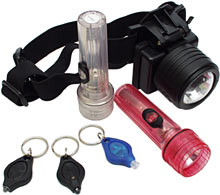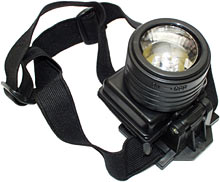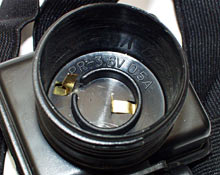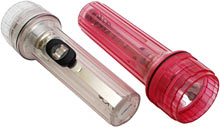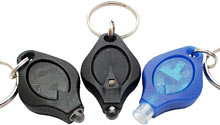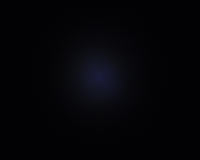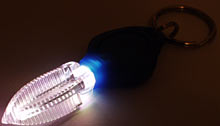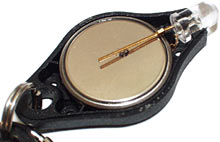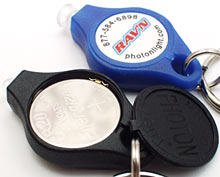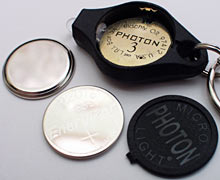
Tektite Avalanche 6, Sino Union Starlite 213R and Photon Micro-Light LED flashlights
Review date: 5 September 2001.Last modified 03-Dec-2011.
Want a cheap LED flashlight? Want a really tiny one? Want one you can strap to your head?
Can do.
The little things in the foreground are Photon Micro-Lights, which can fairly be described as the best keyring lights in the world.
The normal flashlight-shaped things in the middle are Sino Union Starlites. I've looked at the two-AA-cell version of the Starlite before, here; these are the baby single-AA-cell versions. They're simple, straightforward and cheap, and they come in various merry colours.
The funny looking black thing in the background is the Tektite Avalanche 6 headlamp.
The Photons are great, within their limits. The Starlites are great for the money. The Avalanche...
Well, let's deal with the Avalanche first, shall we?
Lumpy lighting
This isn't the first LED headlamp I've looked at. I reviewed the excellent, but expensive, 10-LED FrontaLED Trekker headlamp a little while ago here.
The Avalanche 6 is the same sort of idea - an array of high intensity white LEDs powered by AA batteries, which you attach to your head with elastic straps. But it's not done nearly as well.
First, the good stuff. The Avalanche 6 only costs $US49.95. That's a lot compared with headlamps that use an ordinary incandescent filament bulb, but it's much less than the price of the FrontaLED Trekker. The Trekker's 232 Swiss francs, which is about $US137 as I write this. It's a brilliant product with several nifty features, but it's not for the poor.
Tektite also have a two-LED version of the Avalanche, which only costs $US24.95.
The Avalanche 6 also has quite respectable light output. When I pointed it at my standard beam-power test target, a sheet of A3 paper hanging long-side-horizontal 40cm away from my ISO 100 F2.8 digital camera, and gave it a 1/20th second exposure...
...this was the result, with the Avalanche shining at the paper from right next to the camera lens.

Here's the 1/20th second output from the FrontaLED Trekker in its full power mode, for comparison.
Pretty similar output, on the whole, despite the Trekker's extra four LEDs. Both lights have output as bright as a modest incandescent headlamp, which means they're more than adequate for a lot of caving and general purpose hands-free-light applications. Both lights also give a nice diffuse clean white illumination, against the uneven yellow light from incandescents. White LEDs are good that way.
Unfortunately, though, that's it for the good news about the Avalanche 6. Looking closer at it reveals a few... quirks.
It's easy to unscrew the Avalanche's lamp cover and get out the major parts. It's a simple enough design.
This lamp assembly is very similar to various other Tektite lamps, and it works much the same way - a contact in the middle, another contact around the outside, concentric solder tracks with LEDs bridging them. You turn the front of the lamp assembly to make contact and turn the lamp on; that's how the other Tektite lights I've reviewed switch, as well.
The other Tektite lights I've looked at were, and are, solid products. They use the same bodies as Tektite's conventional-globe flashlights, but the LED lamps are well integrated and the result doesn't look like a retrofit job. Lots of LED lamp assemblies have been shoehorned inelegantly into ordinary flashlight bodies by hobbyists and hopeful manufacturers, and many of them are pretty gimcrack solutions. But the Tektite designs work well.
Except for this one. The Avalanche is a shoehorn job.
Observe, if you will, the contacts inside the lamp. It looks as if Tektite have just chopped out an incandescent bulb holder, and twisted the copper-strip contacts up so that they make contact with the LED lamp when you tighten it lamp down by twisting the housing. This works, but it creaks and squeaks and feels cheap and unreliable. It never switches at the same point twice in a row.
If you still thought this thing was made to be an LED lamp, check this out:
That's a spare bulb, folks. A normal flange fitting incandescent filament krypton-filled globe. It's clipped into the hinge assembly, and you can poke it out of a matching hole in the forehead rest easily enough; a removable piece of foam helps retain it.But don't bother doing that, because the Avalanche doesn't have any place where a flange fitting bulb can be installed, any more. It's got LEDs instead. So what the heck the bulb's doing there, besides making this really obviously a butchered incandescent light, I don't know.
The Avalanche is also uncomfortable. All of its weight is on the front of your head, and it sticks out a fair way. The FrontaLED Trekker has the slim lamp assembly on the front of your head and the slim battery pack around the back; the Avalanche has one less battery and doesn't weigh any more than the FrontaLED, but all the weight's on the front, and the only padding between your forehead and the plastic lamp bracket is a couple of layers of elastic strap. Ugh.
Another problem with the Avalanche 6 is that it's too power hungry for its batteries.
The Avalanche battery bay is covered by a rubber cap with "Water Proof" stamped on it; Tektite describe the light more fairly as "water resistant". You can wear it in the rain; you can't wear it diving.
Three fresh alkalines totalling 4.78 volts, unloaded, were sucked down to 4.15 volts by this lamp. It drew about 500 milliamps (mA) doing it. That's nearly twice as much current as the FrontaLED Trekker draws from its four AAs. It's also about 80mA per LED, which is as much as I've seen any LED light draw, and which may or may not considerably shorten the working life of the LEDs.
Mind you, they'll probably still have a lot more life than any 50 consecutive regular globes, and LEDs don't suddenly burn out when they're overdriven a bit - they just slowly lose brightness over time.
On the plus side, 500mA at 4.15 volts makes this a better-than-two-watt light, which explains its respectable output. But it's not kind to the batteries. 500mA is more than five times what you ought to draw from a AA alkaline, if you want it to deliver something like its rated capacity.
The Trekker has regulator circuitry and runs from one more cell than the Avalanche; from fresh batteries, it only drew 265mA. It's got more LEDs than the Avalanche and drives them more gently, which puts them at a better point in their efficiency curve and means that it gets about as much light output as the Avalanche, but only needs about 1.55 watts of input power to do it. The Trekker also has a lower brightness mode, which is kinder to the batteries again.
Tektite allege that the three AA alkalines included with the Avalanche 6 will "power the light for well over 15 hours and continue to give off usable light for another 40 hours".
If you think you're going to get full brightness out of this thing for 15 hours, you're dreamin'. Even with the best AA alkalines and a current draw a hundredth of the Avalanche's, you won't get more than three amp-hours (Ah) of capacity out of AAs. 500mA draw will give you less than half of that capacity - probably a lot less than half - but even if you got the full 3Ah, it'd still only be six hours of light.
Of course, as the batteries flatten, their output voltage falls, and the current the unregulated Tektite lamp thus draws from them also falls. So you actually will get substantially longer battery life than you would from a genuine, constant half-amp load. But if you don't want to put up with half brightness or worse, you'll be swapping batteries a long time before that 15 hour mark.
Bear in mind that LED lights all work well with near-flat batteries, because LEDs don't change colour much as their input voltage falls. Filament lamps get cooler and cooler, and redder and redder, as they dim; red light is less visible, and infra-red light isn't visible at all. White LEDs don't know how to make anything but white light, so at one-tenth power they work a lot better than a similarly dimmed incandescent. But they're still not magic.
You're likely to get longer bright light duration out of the six-LED Avalanche if you use it with 1.5Ah nickel metal hydride (NiMH) rechargeable AAs, which are commonly available, instead of alkalines. NiMH and nickel cadmium (NiCd) AA cells laugh at a mere 500mA load. They can deliver full capacity at their rated 1.2 volts per cell with no trouble at all, even if you ask for an amp or more. Three NiMH AAs will only ever be good for 3.6 volts in total, so they'll only give you about three quarters of the brightness of brand new alkalines in the Avalanche 6. But the alkalines will rapidly dim, and the rechargeables won't.
The only reason not to use NiMH cells in a light like this, besides the cost of the cells and their charger, is that NiMH cells have a crummy charge life if you just leave them sitting on the shelf - they have high "self-discharge". If the light's going to be sitting there for three months, alkalines that were fresh when you put it on the shelf will still have virtually their full capacity. Freshly charged NiMH cells can lose about four-fifths of their charge in only three months - the warmer they've been over that time, the less charge will remain.
Nickel cadmium (NiCd) cells have pretty fast self-discharge too, but they're not as bad as NiMH. Then again, NiCds have less capacity in the first place, so there's no real advantage.
If the Avalanche were really cheap, it'd be a good product. But it isn't. I've been impressed with the other Tektite products, but this one leaves me cold.
Tektite sell headband and helmet strap rigs that let you attach their other small flashlights to your head. I'd definitely prefer one of those to the Avalanche.
Cheap and cheerful
Sino Union Technology have managed to make LED flashlights that don't cost a fortune. They're not waterproof to a zillion feet, or brighter than similar-sized incandescent-bulb lights, or going to win any design awards. But they work, and they're cheap.
These are Starlite 213Rs, the babies of the Sino Union range. Like the two-cell Starlites, these ones have a single-LED "bulb" with a DC-to-DC converter built into it, which boosts the input voltage to run the LED. These lights run from just one AA cell, and so they're compact little things; 104mm long and 34mm wide at the big end (4.1 by 1.3 inches).
Retail, 213Rs only cost $US7.80 each, ex shipping. Which is pretty darn cheap for a neat little LED light. Sino Union are still looking for distributors, but you can buy directly from them; contact them via e-mail for details.
The "Night Pearl" lamps now look better than they did the last time I got some Sino Union stuff to play with. The older lamps have a slightly home-made look, with visible solder joints; the new ones are a slicker product with a nifty shiny conical plinth around the LED.
The "bulb" on the left in the above picture is the "NPLB-213R" one from the Starlite 213R. Its nominal voltage and current ratings are 1.43V and 0.2A; they're now stamped on the lamp as normal for filament globes. The older Night Pearls have no markings.
The lamp on the right in the above picture is a two-cell NPLB128R. Its nominal ratings are 2.85V and 0.1A.
Both lamps are of the profiled-LED type; the LED doesn't have the normal full domed lens over the top of the light-emitting die, and so it emits light over pretty much the same angular range as a normal incandescent bulb. This makes it easy to swap these lamps into normal one or two cell torches. As before, these lamps will fit in any flashlight that expects a normal flange-fitting globe and uses the right number of cells.
If you'd like to refit some flashlights, Sino Union will sell you the lamps by themselves. They retail for $US4.80 each, for the NPLB-128R, or $US5.80 each, for the NPLB-213R. That's ex shipping again, but it shouldn't cost much to ship things this small.
How do the little Starlites perform? Pretty well.
Here's the light-intensity test. These lights have a tightly focussed beam, which isn't great if you want to use them for finding your way around the house at night, but is excellent for longer range purposes.
They're not as bright, or as tightly focussed, as the LEDCorp tight-beam single-LED flashlights I review here, but those lights cost rather more, are a lot bigger, run from four AA cells, and have larger reflectors as well. For a pocket torch, the little Starlite does very well.
They're not monsters in the power consumption department, either. But, oddly, the two one-cell Starlites I got actually had somewhat different bulb power.
The clear Starlite's lamp yanked a fresh 1.57 volt AA alkaline cell down to 0.99V, and drew 119mA in the process. That's 118 milliwatts, and not at all a horrible amount to draw from a single AA.
But the pink Starlite's nominally identical lamp pulled the same cell down to 0.87V, and drew 143mA - 125mW.
The actual output power difference is trivially small - minor differences in the beam focus made a much bigger difference to the way the beam looked - but the higher current draw of the pink flashlight's lamp means it'll eat batteries a bit faster. The effective resistance of the higher current lamp is only 73% of the other one's score.
A Starlite 213R will still only use one AA cell at a time, of course; nobody's going to go broke feeding one of these things. And 143mA isn't a horribly high current draw. The Avalanche headlamp's hauling three and a half times as much current out of its poor little AAs.
I also tested the NPLB-128R two-cell lamp; it pulled a pair of fresh alkalines totalling 3.11 unloaded volts down to 2.54, and drew 109mA doing it. 277mW. This is significantly more power than the earlier, uglier Starlite two-cell lamps; they only managed about 0.23 watts. But this still isn't a high enough draw that AA alkalines are going to be gasping to deliver it.
As I noted in the last Starlite review, none of these lamps delivers anything like as much light as a normal two cell flange fitting torch globe. But they deliver high quality light, they're bright enough for many purposes, and they're much kinder to the batteries. The Starlite torch bodies are decently made, the switches feel OK, and they're good value for money. Worth considering.
Bright babies
On to the Photons.
On the left, a white-LED Photon 3. On the right, the blue and funky "RAV'N Party Light", of which more in a moment. In the middle, one I prepared earlier - a turquoise-LED Photon II that's been hanging from my keyring for some time.
The manufacturers, LRI (which stands for Laughing Rabbit Incorporated, of course) now make three basic flavours of Photon Micro-Light, confusingly called the I, II and 3. All of them come with a variety of different LED colours.
The Photon I has a simple momentary switch; if you're not squeezing it, it's not turned on. The Photon II has the same switch, plus a slide switch that lets you lock it on. The 3 adds microprocessor control. And the Rav'n is... special.
The obvious Big Feature of all Photon Micro-Lights is that they're really, really small.
My Photon II, not counting its keyring attachment, is 40.4mm long, 23.7mm wide and 6.9mm high (1.59 by 0.93 by 0.27 inches), if you ignore the little bulge of the guard in front of the always-on switch. The Photon 3 is a weeny bit less long (because its LED sticks out less) and a tad wider and taller (because of its fancier design), but the difference is barely noticeable. The Rav'n is the same as the III, but a bit longer, because of the plastic shroud around its LED.
Photon make "covert" versions of their lights with a shroud like this; it stops light from the side of the LED from being visible. But the covert lights have a black shroud. The Rav'n has a translucent one. There's a reason for this, which we'll get to shortly.
The less obvious feature of the Photons is they're quite remarkably bright.
Anybody who's played with high intensity LEDs lately will know how bright even a single-LED flashlight can be, particularly if it doesn't use a white LED. White LEDs give a marvellously clean broad-spectrum blue-white light (most of them have a colour temperature of about 6500 Kelvin, which is the same colour as the light you get on an overcast day, and considerably whiter than direct sunlight), but they achieve this feat by using a special phosphor layer over a blue LED. That eats some efficiency.
If you don't need white light, plain green, blue-green and blue LEDs are considerably brighter than white ones, and rather more efficient than any normal filament bulb.
The brightest Photon you can buy is the turquoise model. Only the Photon II and 3 can be had with a turquoise LED; they cost $US19.95 and $US25.95 respectively, including US shipping, direct from the Photon site. Photon Is are significantly cheaper, at $US11.95 each, also including US shipping. Batteries are included with all Photons.
The Photon 3 is more expensive than the II because of its microprocessor control. It's got a two-way switch; the front of the switch gives you full power momentary operation, just like the Photon I, but if you press the back of the switch, you get a variety of other modes.
The Photon 3 I got for review has a white LED; here's its full power output, taken with the same 1/20th exposure used for the earlier beam shots:
This may not look very thrilling, but it's actually quite good for a single-white-LED wide-beam flashlight. The Photon LED has a relatively narrow 20° beam angle, but that's relatively narrow by LED standards, not by flashlight standards. It's fine for looking where you're walking; it's not so great for seeing things beyond spitting distance. For the size of the thing, though, it's still quite remarkable.
The Photon 3's light looks blue-ish because it is. This is a higher colour temperature LED than the ones in the Avalanche light, which is what I used to set the camera white balance. Just looking at it, you'd say it was white, but it's noticeably bluer when compared with many other "white" LEDs.
Press the back of the Photon 3 switch once (after removing the little bit of plastic that's wedged in there at the factory, to stop people running the light flat while it sits in its packaging) and, by default, the light latches on at full brightness until you press the switch-back again.
Hold the switch for four seconds, though, and the Photon switches to a dimmed mode...
...which doesn't make much of an impression at 1/20th second.
Here's a 1/10th second exposure.
This level's actually still perfectly adequate for seeing where you're going, generally, and for many other close-up tasks. It's also gentler to the batteries. Which matters, as we'll see.
When you've cycled to this dim level, it's what you'll get every time you press the back of the button, until you hold down the button for another four seconds to cycle to the next mode.
Which is this - the second dim level. This is a 1/10th second shot...
...but I needed 1/5th second to make it look like something. It's got around a third of the brightness of the first dim level, but it's still quite bright enough to read by.
Both dim modes are achieved by rapid full-brightness pulsing of the LED. Decreasing the on-to-off ratio or "duty cycle" of the pulses dims the perceived brightness; the light's on at full brightness when it is on, but the average output is lower. This "pulse width modulation" allows dimming without reducing the voltage sent to the LED. This matters, because just reducing the voltage will also, beyond a certain point, drastically reduce an LED's efficiency. Some lights I've reviewed before use the same technique.
The pulsing's not very noticeable if you're shining the light on something stationary. But if things, or the light, are moving, a strobe effect becomes apparent.
Pulsing becomes a lot more apparent if you cycle through to the Photon 3's other modes.
After the dim modes, there are four flash modes - a fast somewhat strobe-y one, a slower one, a very slow "warning light" one, and then a medium-rate one. This last mode is the auto shut-off mode; the medium-speed flash happens for a few seconds to tell you what mode you're in, then you get full brightness for a bit less than a minute, then a few more seconds of flashing, and then the light turns itself off. Hold the button to cycle past this mode, and you're back to full power again.
So how bright's the turquoise LED in comparison?
Well, when I first looked, not very. Because the batteries in my old Photon II had never been changed since I got it, and were rather tired.
This is all they could manage, at 1/20th second. The turquoise light still lit up any given area about as brightly as the Photon 3 in its first dim mode, though, and the turquoise LED has a 30° beam angle. So quite a lot more actual small-p photons were being ejected from the turquoise LED than from the white one.
When I swapped in some new batteries...
...this is what I got.
Ah yes. I remember why I bought it, now. It's annoyingly bright from fresh batteries. People think it's alien technology, or something.
More on the batteries and how long they last in a moment.
Time for the show pony.
The Rav'n Party Light has a suspiciously similar name to an earlier EternaLight product, and it has some other similarities, too.
Here's the Rav'n, with a 1/10th second exposure, held close to the test screen so you can see its light. It's not very bright (it beats the heck out of finding your way around by the light of your mobile phone, but that's about all that can be said for it), it's got a frosted LED that doesn't really throw a "beam" at all, and it's only got a one-mode switch. It's like the Photon 3, but without the front-of-switch momentary mode; you press the back of the switch only, and that turns the Rav'n on or off.
Turn it on and hold it still, and the Rav'n looks like a rather flickery white light.
Move it around, though...
...and that's not how it looks.
This thing is a rave toy - a glowing accessory made to allow people to contribute to the light show at the dance venue of their choice. And it's a very elegant one, too. Its four-wire LED flashes red-green-blue-red-green-blue at a nicely judged rate to allow persistence of vision to create coloured trails in the air when you wave it around.
There are two versions of the Rav'n, "Strobe" and "Ribbon"; Strobe makes a line of dots, while Ribbon (the one I got for review) makes a continuous line of light.
The Rav'n is targeted with merciless precision at people who already know various tricks that impress the thoroughly Ecstacied, and it's also fine for people who just want a piece of jewellery of rare funkitude.
And, since it's a Photon, it's small and light enough that you can hang it from an ear (or other body part) ring. Or festoon yourself with dozens of the things, if you like, as long as you can afford the $US31.95 per unit price. Including, again, US shipping.
LRI are, presumably, reasoning that rave-goers commonly pay rather more than $US32 for things rather smaller than a Photon Light. And those things usually only last one night. Even if they don't turn out to be aspirin.
For your money, you don't just get a light, batteries and an instruction sheet, as with the other Photons. There's also a little pseudo-velvet storage bag and three clear plastic "Crystals" which fit firmly onto the shroud at the end of the light.
The Crystals very effectively spread the light, and make the Rav'n effect rather prettier. You can buy them separately, and you can also get other single-colour Photons with the clear end shroud. A collection of different-coloured Photon 3s in strobe mode, with crystals, is one of LRI's serving suggestions.
As a flashlight, the Rav'n isn't useless, but it certainly wouldn't be my first choice. As a Pretty Thing, it's a huge success.
So how long do the batteries last in Photons?
Good question.
First off - different Photons have different batteries. They all run from 20mm wide three volt lithium coin cells, but the brighter Photons use a pair of 1.6mm thick CR2016 cells, while the dimmer ones (the red, orange, yellow and infrared models) run for longer on a single 3.2mm thick CR2032.
Replacing the battery or batteries in a Photon II is a bit fiddly. The II has a screw-together body, so you need a little screwdriver to get into it.
This is all there is to the Photon II's switch. One leg of the LED is cut short and bent under the lithium cells, and the other leg's on top. Pressure on the hinged top of the case pushes down the top leg, and completes the circuit. Clicking the little lock-switch back pushes the top leg down constantly.
Various other teeny-lights also have similar ridiculously simple switch designs, but not all of them actually work properly. The Photon switch does work, and keeps working. The thing always glows when you squeeze it. It never glows when it's not squeezed. It doesn't wear out or jam.
The Photon 3 and Rav'n have a pop-off battery lid similar to the one on the Photon I. You can remove it with a little screwdriver or nail file...
...and then it's easy to replace the batteries.
This is something you may not have to do for years. Or may have to do daily. It depends a bit on what Photon you've got, but mainly on how you use it.
Lithium coin cells have superb shelf life - you could put a Photon on the shelf for ten years and it'd still have plenty of juice left when you took it down. But coin cells are very very small, and so have low capacity. And they also don't like high current. Which is what, comparatively speaking, a single high intensity LED demands.
CR2016 cells have a capacity of only 60 milliamp-hours (mAh). 70, maybe, if they're good quality ones. CR2032s manage maybe 140 or 150mAh.
This capacity, though, is generally calculated based on a typical drain of only 0.1mA (100 microamps). That's the kind of drain these cells generally have to face, in their role as memory backup batteries in various gadgets, or when they're powering wristwatches.
You can use a coin cell to run a high brightness LED for ages, as long as you don't want the LED to be on for more than brief instants. Flasher circuits that gently charge a capacitor to pulse an LED for a brief but highly visible moment every second or so may only draw about 30 microamps. That'll give you a genuine three month continuous-use life from a CR2016. More, if the flash rate drops as the cell discharges, which it will when the flasher's a simple capacitive discharge circuit and not an IC-controlled setup.
When I tested the Photons, though, they all drew a heck of a lot more than 0.1mA.
The old cells in my turquoise Photon II tested at only 5.65 volts between them - which means they're pretty well used, since one of lithium batteries' features is their stable output voltage over their whole life, compared with alkalines. Connecting the LED to these worn-out cells caused them to sag to only 3.35 volts, and only 4.8 milliamps of current flowed. That's only about 16 milliwatts of power.
Next, I tried a couple of fresh CR2016 cells. These ones tested at 5.94 volts together, and sagged only to 4.3 volts under load from the turquoise LED. Which is still a big sag, and indicates the relatively massive load a high intensity LED puts on these things. Far more current was now flowing - 50mA on first connection. The current, and the voltage, fell noticeably over only seconds; 50mA is to a CR2016 a lot worse than 500mA is to a AA cell. The initial turn-on power was a hefty 215 milliwatts.
The white Photon 3 is even greedier. It drew 60mA from fresh button cells, hauling them down to 4.1 volts, for 246mW of power, in full-on mode. At its medium brightness level it drew 15.5mA, and the cells managed 5.1 volts (which adds up to 79mW); at lowest brightness, the current draw was only 4.5mA, and the cells managed 5.4 volts, which means 24mW.
All three of the Photon 3's flash modes seem to draw about the same current. The flash rates are different, but the duty cycle is the same for all of them. They all seem to draw around 25mA on average, and suck the batteries down to about 4.7V. 118mW.
The Rav'n is relatively gentle to its cells, which is just as well if you intend to hang the thing from your navel ring and dance all night. The one I got drew only 19mA from fresh cells, which caused them to sag to only 5V. 95 milliwatts. Presumably the "strobe" model's a bit gentler again.
The manufacturers quote a 12 hour battery life for the turquoise, green and white Photons. Well, yes, I dare say they still will be emitting a non-useless amount of light after 12 hours. My faithful turquoise still gave enough light to read a watch when I connected only one of its worn-out cells. But after 12 hours of on time, these things sure as heck aren't going to be nearly as bright as they were when new.
People who're convinced that their Photons get spectacular battery life have actually just demonstrated that they're happy with a heck of a lot less brightness than the thing can deliver with fresh batteries. Which is fine, of course, as long as you know about the light's behaviour up front.
If you use your Photon a lot and not just as an occasional keyhole finder, you're therefore likely to be buying a lot of coin cells. Which can cost more than AAs, if you shop poorly.
The Photon manufacturers will sell you a pair of CR2016s for $US5 including US shipping, or a single CR2032 for $US2.50. Look in the batteries and accessories section.
Here in Australia, CR2016 and CR2032 cells are $AU3.36 each for fewer than 8 from Jaycar. Buy eight or more and they're $AU3.45 each, and 15 or more are $AU2.99 each. Since these batteries have a very long shelf life, you might as well buy a stack of 'em to get yourself the discount. When I bought some from Jaycar I got quality Toshiba cells, not maybe-lousy Chinese-brand ones.
Perusing the Web, I found plenty of stockists selling single CR2016s for $US4 or more, ex shipping. But there are some much better deals around. UK buyers could try Batteries Online, for instance, which has cards of two Maxell CR2016s (in their "other" category) for £1.75. PhotoGlossy.com, also in the UK, used to sell Varta CR2016s for 75 pence each, but they're up to £1.25 now.
Thomas Distributing in the US has CR2016s for $US1.30 each, and wholesaleadvantage.com has them for 95 US cents. If you're outfitting your whole police station, company or terrorist organisation with Photons, Mouser Electronics have individual cells for $US1 or less - but will also sell you a case of 250 of the blighters for only $US94.50!
If you're in the States, though, you'll probably do better to search for "cr2016" on eBay. I found $US8.50 Buy It Now prices for packs of 20 CR2016s, but none of those auctions offered international shipping. They're available on eBay Australia now and then for similarly decent prices.
Clearly, a lot of people don't bother replacing their Photon's batteries until they're really, really dead. Which is very environmentally sound of them. But if you want to keep your teeny-light at tip-top brightness, shopping around for a good battery deal seems a rather good idea.
Overall
Tektite have some very interesting new products, which I hope to be able to review soon. The Avalanche 6 is not one of these products, though. It's uncomfortable, it's mean to its batteries, it feels cheap, and I still don't know what on earth that spare bulb's doing in it.
The little Sino Union Starlites aren't the world's finest LED flashlights, but they're much cheaper than most, and they run from a single AA cell; built in DC-to-DC converters still aren't a common feature. They're fun. I like them.
Photon Micro-Lights are a deservedly popular product. The Photon 3's dim modes let you save its weeny little batteries, the turquoise Photons are disturbingly bright, and the Rav'n is a very hard gadget not to like.
If you don't need a really minuscule light then, for around the same money, allow me to highly recommend the Arc-AAA I review here; it's still not a big light, but its single AAA cell will give you a genuine five hours of bright light, and at least that much again in a dimmer mode, and it comes in various LED colours, including turquoise. But the Photons make even the Arc look fat. And there's nothing quite like the Rav'n.
As well as simple keyring light use, Photons are great as a high reliability second light, for cavers and mountaineers and such who normally use a bigger, brighter light, but really want something to see by while they change the batteries, bulb, carbide granules, propane canister or oil-soaked length of rag (as the case may be) in that other light. If there isn't room for a Photon Micro-Light in your pack, you deserve some sort of medal for Advanced Luggage Configuration.
Corporate types should note that LRI also make custom labelled Photons, which explains the penguin Photons available from ThinkGeek. If you're considering giving your employees balloon bouquets or some similar useless token that'll encourage them only to let down your BMW's tyres, a company-branded Photon purchase will let you give them a useful token instead. Just a thought.
Tektite Avalanche 6 kindly provided by Tektite Industries
Sino Union flashlights kindly provided by Sino Union Technology
(Sino Union products are available in the USA from Sinotone International Limited in San Francisco. Phone (650) 583-8306, fax (650) 583-8326, e-mail sinotone@yahoo.com.)
Photon Micro-Lights kindly provided by Laughing Rabbit Incorporated (L.R.I.)
